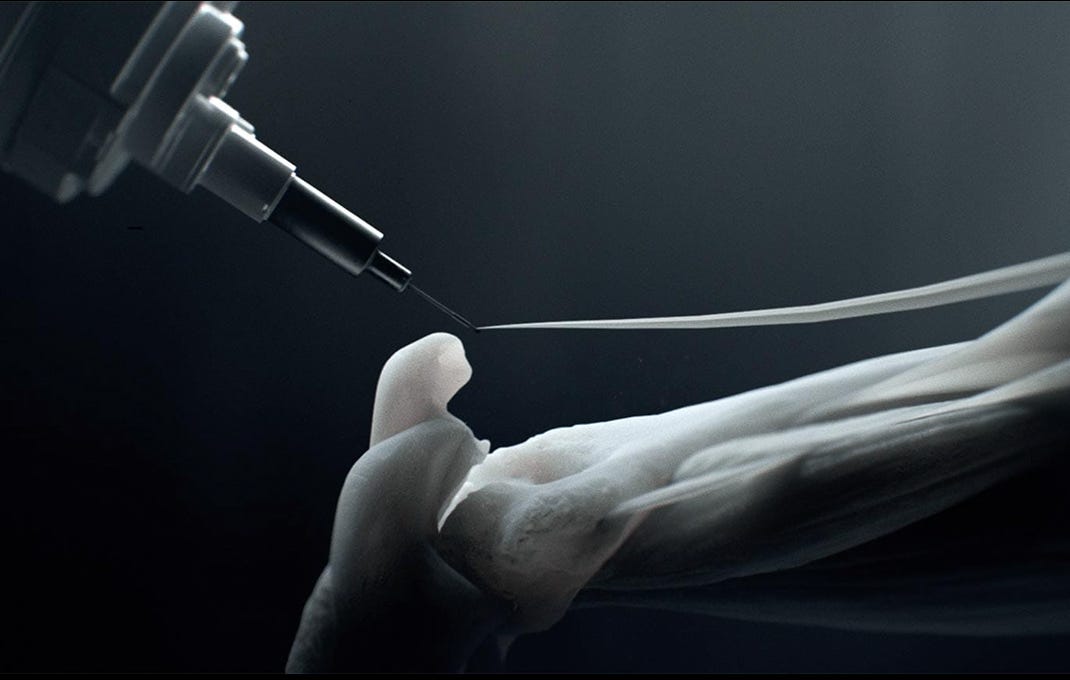#9:🫀3D Printed Organs
New Bioinks allow better integration with cells
Welcome! If you haven’t subscribed, join this curious group by subscribing here:
💬 In this note:
🕸 Decentralized Tech Transfer
🫀 Granular Bioink for 3D Printing Organs
🦟 Skin Smell Attracts Mosquitos
📚 Book of the week
Decentralized tech transfer
In the world of decentralized science (DeSci), technology transfer (TT) is a primary obstacle. Typically discoveries originate in an academic lab, and in this situation, the university's Technology Transfer Office (TTO) owns the intellectual property (IP) created by scientists during their time at the university.
This ownership is due to the Bayh-Dole Act, passed in 1980 and granting IP ownership to the institute receiving federal funding to conduct the research. The act sparked innovation, and profits, because it created a system in which IP rights can be sold to corporations or spun-out into start-ups through licensing or IP transfer.
In the beginning this was beneficial, but with time the TTO has created huge time delays and bureaucratic difficulties. University employees within the TTO are there to uphold the interests of the university, which in essence works against the scientist who created the IP, as they fight to create the largest economic gain for the university.
Enter Decentralized Technology Transfer (DTT). DTT is being spearheaded by key disruptors in the DeSci movement - Molecule & VitaDAO. DTT gives ownership and more power to the researcher that created the IP, allowing scientists to take their IP outside of the university outside of the traditional tech transfer route, while also being compensated for their contribution.
Uncoupling IP from research institutes unlocks the potential for new research funding opportunities in which the researchers receive compensation for their work.
VitaDAO proposes how DTT could work in their VDP-45 governance proposal. Together with a researcher network and a Contract Research Organization (CRO) network, VitaDAO proposes a path to create IP outside of the limitations of research institutes.
I spent a year of my PhD working at the University of Arizona’s TTO giving me particular insights into how the process for releasing intellectual property works. The process was very bureaucratic with the need for substantial commercial evidence to back up the market need for the IP, and the TTO would not release several technologies that did not show market demand in the current market conditions. This was very short-sighted and trapped a lot of IP at the university.
🫀 Granular Bioink for 3D Printing Organs
Welcome to the future. A recent paper demonstrates that we are getting one step closer to 3D printing organs, like humanoid 3D printer in the HBO series, Westworld. Spooky. 👻
Existing bioinks use a material called Bulk Hydrogel to enable 3D printing of artificial tissues and organs. These materials primarily consist of polymers which store a lot of water while maintaining their shape. The downside of hydrogels is that they do not integrate well with the human body.
Penn State researchers have developed an alternative material that is more porous than prior bioinks allowing for better integration with cells. The new material consists of self-assembling nanoparticles and hydrogel microparticles and microgels.
In this article, the inventors say:
“We developed a new generation of granular bioinks made up of micron-scale particles that mimic the materials that form tissues and have enough space between them to readily host cells,” continued Sheikhi.
The team plans to investigate the new material in the field of tissue engineering and regeneration with the plans for the 3D bioprinting of entire organs. Advancements in bioprinting entire organs could mean that in the not-so-far off future, when someone needs an organ transplant, they could receive an organ 3D printed from a bioink blended with their own cells in order to eliminate transplant rejection.
🦟 Are you more attractive to mosquitos than your friends?
Have you ever gone camping and afterwards only one person in the group is covered in mosquito bites while the others are barely touched?
I’m that friend, the mosquito magnet.
Recently, the underlying cause of mosquito magnetism was identified.
A recent study showed that mosquitoes are drawn to the skin scents of certain people over others. The mosquitoes would swarm the subjects with the most attractive scents, and they would come back in multiple experiments to the same subjects.
They even found that some subjects were 100x attractive than the last place finisher.

Subjects that attracted the most mosquitos had high levels of certain acids on their skin. The bacteria that live on the skin eat these acids and produce part of the skin’s odor profile.
Unfortunately, these acids cannot be removed without damaging the skin. However, there is promise for future research into modifying the skin bacteria to change the skin smell.
📚 Book of the Week
I’m on a mission to read 52 books a year, currently on book 48 of 52, and ahead of schedule 🎉. I mostly read fiction (It’s my escape. Sorry, not sorry) with the occasional start-up or science book thrown in.
This week I’m reading Daisy Jones & The Six. The book is written as an oral history telling the story of the tumultuous rise & fall of a 1970s rock band. 100% captivating. Your left wanting more, googling “Daisy Jones” and wishing she was real. It’s currently being adapted to a TV series with the same name.
⚡️ Check this out
The stunning underwater graphics in the Avatar 2 Trailer.
❤️ Enjoy this newsletter?
Forward to a friend and let them know where they can subscribe (hint: it's here).
Anything else? Hit reply to send me feedback or say hello.
If you haven’t subscribed, join this curious group by subscribing here:



